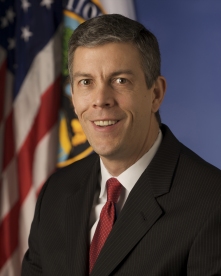 At a luncheon today at the National Press Club, during which he announced the finalists for round two of Race to the Top, Secretary of Education Arne Duncan spoke about the education reforms that the Obama Administration is undertaking, and what lies ahead for federal education policy. Secretary Duncan stressed that as the United States lags behind other nations in science, math and college completion, that we must educate our way to a better economy. Some strategies for improving student achievement and restoring the United States’ position as first in the world in college graduates include federal incentives such as Race to the Top, Investing in Innovation grants, and the Teacher Incentive Fund; a change in ESEA accountability systems; and common standards, as well as the curriculum and assessments to accompany new standards.
At a luncheon today at the National Press Club, during which he announced the finalists for round two of Race to the Top, Secretary of Education Arne Duncan spoke about the education reforms that the Obama Administration is undertaking, and what lies ahead for federal education policy. Secretary Duncan stressed that as the United States lags behind other nations in science, math and college completion, that we must educate our way to a better economy. Some strategies for improving student achievement and restoring the United States’ position as first in the world in college graduates include federal incentives such as Race to the Top, Investing in Innovation grants, and the Teacher Incentive Fund; a change in ESEA accountability systems; and common standards, as well as the curriculum and assessments to accompany new standards.
During the Q&A portion of the event, a question was submitted that asked whether the United States needed more CTE. The Secretary responded that yes, students will benefit from programs such as apprenticeships that allow students to “work with their hands,” that provide a range of options, and that give students a reason to stay in school. He went on to remind the audience that CTE does not happen just at the secondary level, and that community colleges play a vital role in training students in emerging fields such as STEM and green technologies.



